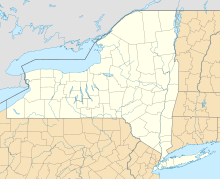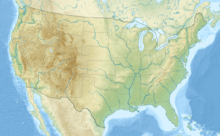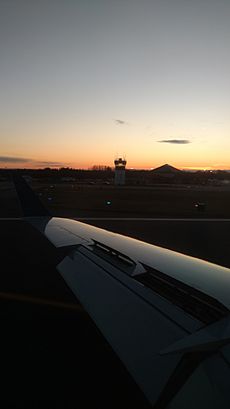Ithaca Tompkins International Airport facts for kids
Quick facts for kids
Ithaca Tompkins International Airport
|
|||||||||||||||
|---|---|---|---|---|---|---|---|---|---|---|---|---|---|---|---|
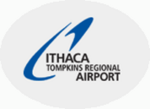 |
|||||||||||||||
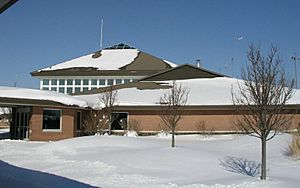 |
|||||||||||||||
| Summary | |||||||||||||||
| Airport type | Public | ||||||||||||||
| Owner | Tompkins County | ||||||||||||||
| Serves | Ithaca, New York | ||||||||||||||
| Location | Lansing, New York | ||||||||||||||
| Elevation AMSL | 1,099 ft / 335 m | ||||||||||||||
| Coordinates | 42°29′29″N 076°27′31″W / 42.49139°N 76.45861°W | ||||||||||||||
| Map | |||||||||||||||
| Runway | |||||||||||||||
|
|||||||||||||||
| Statistics (06/2014 - 06/2015) | |||||||||||||||
|
|||||||||||||||
|
Sources: FAA and airport web site
|
|||||||||||||||
Ithaca Tompkins International Airport (airport codes: ITH, KITH) is an airport owned by Tompkins County. It is located in Lansing, New York, about three miles northeast of Ithaca, New York. Ithaca is the main city in Tompkins County.
The airport is considered a "primary commercial service" airport. This means it offers regular flights for many passengers. In 2018, over 99,000 passengers boarded flights here. You can fly nonstop from Ithaca to major airports like John F. Kennedy International Airport and Newark Liberty International Airport.
Contents
History of the Airport
The first airport in Ithaca was called Ithaca Municipal Airport. It was located west of downtown Ithaca, near Cayuga Lake. In 1914, a pilot named Charles Niles thought this spot would be good for flying. The Thomas Brothers Aeroplane Co. also moved to Ithaca in 1914 and started a flying school there in 1915.
Ithaca Municipal Airport opened before 1916. It is thought to be the second airport ever built in New York state. At first, it had two grass runways. By 1937, it had an asphalt runway that was about 823 meters (2,700 feet) long. Because it was by the lake, the airport also had a dock for seaplanes. However, the airport couldn't grow much because it was surrounded by train yards, marshes, and fog from the lake. The old airport site is now a park called Cass Park. An old airplane hangar there is now a theater.
In 1946, Cornell University and the city of Ithaca started planning a new airport. This new airport was built on land owned by Cornell in Lansing, New York. It was called East Hill Airport and opened in 1948. Robinson Airlines was the first main airline to use it. On July 1, 1956, Cornell University sold the airport land to Tompkins County for $324,500. After this, East Hill Airport was renamed Tompkins County Airport. Later, it became Ithaca Tompkins Regional Airport.
The original municipal airport was where aviation pioneer Cecil Robinson started his aerial photography business. After World War II, he created Robinson Airlines there in 1945. His airline moved to the new East Hill Airport in 1948. In 1952, Robinson Airlines changed its name to Mohawk Airlines. Over the years, many different airlines served the airport, including Empire Airlines, Air North, and others that later merged into larger companies like US Airways and American Airlines.
Airport Expansion and Changes
In 1994, a new, larger terminal building opened. It was about 3,066 square meters (33,000 square feet) and cost $11 million. At the same time, the main runway was made longer, from 1,768 meters (5,801 feet) to 2,012 meters (6,602 feet). In 2009, the runway was extended again to its current length of 2,127 meters (6,977 feet). This was part of a safety project.
In 2001, the airport changed its name again to Ithaca Tompkins Regional Airport.
In 2005, Northwest Airlines started flights to Detroit Metropolitan Wayne County Airport. In 2008, Continental Connection began flights to Newark Liberty International Airport. By 2011, the airport served over 242,000 passengers a year.
In 2017, the airport received $2.4 million in grants to improve its facilities. United Airlines also announced that it would use larger, 50-seat jet aircraft for its flights to Newark, meaning all commercial flights from Ithaca would be on jets.
In 2018, New York State Governor Andrew Cuomo announced a big project to make the airport terminal much larger. This $22 million project would add six new gates, three new jet bridges, and a customs facility. The customs facility would allow international flights to come to Ithaca. The airport was then renamed "Ithaca Tompkins International Airport." The project was completed in December 2019, costing about $34.8 million.
In July 2018, American Airlines started nonstop flights to Charlotte, North Carolina. However, due to the COVID-19 pandemic, flights to Philadelphia International Airport were stopped in September 2020.
Airport Facilities
The airport covers an area of 215 hectares (531 acres). It is located at an elevation of 335 meters (1,099 feet) above sea level. The airport has two runways:
- Runway 14/32 is 2,127 meters (6,977 feet) long and 46 meters (150 feet) wide. It is made of asphalt.
- Runway 15/33 is 615 meters (2,018 feet) long and 15 meters (50 feet) wide. It is a turf (grass) runway.
In 2011, there were about 41,286 aircraft operations at the airport, which means about 113 flights per day. Most of these were general aviation (private planes), with some air taxi (small charter flights) and a few airline flights. At that time, 57 aircraft were based at the airport, mostly single-engine planes.
The airport is home to the East Hill Flying Club. This club offers flying lessons and allows its members to use eight small planes. It is also where Taughannock Aviation is located. This company offers private jet charters and manages business jets.
Currently, United Express uses Bombardier CRJ550 jets for flights between Ithaca and Newark. Delta Connection uses Bombardier CRJ900 jets for flights between Ithaca and New York–JFK.
Airlines and Destinations
Passenger Flights
| Airlines | Destinations |
|---|---|
| Delta Connection | New York–JFK |
| United Express | Newark |
Destinations Map
| Destinations Map |
|---|
Statistics
Top Destinations
| Rank | Airport | Passengers | Carriers |
|---|---|---|---|
| 1 | Charlotte, North Carolina | 28,970 | American |
| 2 | Washington-Dulles, D.C. | 23,920 | United |
| 3 | Detroit, Michigan | 12,380 | Delta |
| 4 | Newark, New Jersey | 2,730 | United |
Top Airlines
| Rank | Airline | Passengers | Share |
|---|---|---|---|
| 1 | Air Wisconsin | 47,550 | 34.46% |
| 2 | Piedmont Airlines | 33,530 | 24.30% |
| 3 | PSA Airlines | 26,290 | 19.05% |
| 4 | Endeavor Air | 24,500 | 17.75% |
| 5 | GoJet Airlines | 5,990 | 4.34% |
| 6 | Others | 130 | 0.10% |
Getting To and From the Airport
Bus Service
The TCAT Route 32 bus goes to Cornell University and downtown Ithaca (Ithaca Commons). Buses run every day, usually once an hour. A one-way ticket costs $1.50. Kids aged 6–17 and seniors get a reduced fare of 75¢. You can pay with a TCAT card or with cash, but drivers cannot give change. You can also get free transfers to connect to other parts of Ithaca.
Rental Cars
Companies like Avis, Budget, and Hertz have counters inside the airport terminal. They offer special rates for people connected to Cornell University. The rental cars are parked in a lot right outside the terminal building.
Ithaca Dispatch (which includes Cayuga, University, and Yellow Cab) has a taxi stand at the airport. Sometimes, you might need to call ahead for a taxi, especially when it's busy. Taxi fares to the airport are usually set at a standard price. Ride-sharing services like Uber and Lyft also operate in Ithaca.
See also
 In Spanish: Aeropuerto Regional Ithaca Tompkins para niños
In Spanish: Aeropuerto Regional Ithaca Tompkins para niños


